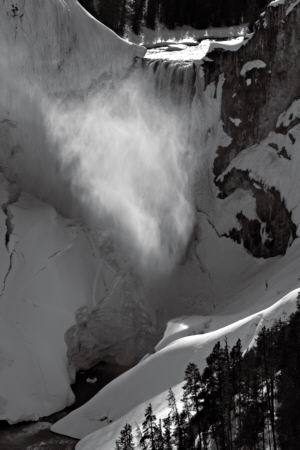Posted by Steve Durbin on June 1st, 2009
 1
1
My day in Yellowstone last month was a long and varied one (see previous posts one, two, three). As I was leaving the park along the Madison river (almost the longest in the U.S.), I stopped occasionally to photograph the line of mountains on the opposite side of the valley.
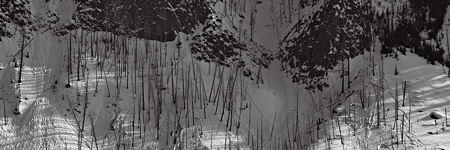 2
2
As I was doing this, I had in mind the images from the month before of the landscape by Tepee Creek (post here). I was hoping to catch some of the rhythm, perhaps even musicality, that I found in both places. I’ve nurtured such a poetic and mostly unrealized hope since I read about photographer Michael Smith’s epiphany with sonograms, like the one below of a hermit thrush. Smith was inspired by the beauty of such sonograms in creating some of his wide landscapes. (Though it’s worth pointing out that Smith’s wife, Paula Chamlee, in her own way, succeeded as well or better.)
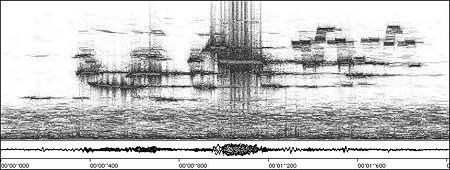
more… »
Posted by Steve Durbin on March 24th, 2009
June’s recent post about trying to gain a sense of personal expressiveness in one’s landscapes—which, on the face of it, are more about the place out there than the one in here—set off resonances. All the more so as I had just returned from a day in the mountains where I had gathered one of my more coherent set of photographs in a mode (style?) I feel I’ve been seeking for some time (all in one 10-minute stint, the only halt of the trip). And then her mentions of Wood and Hockney added to the echoing cacophony.
 1
1
more… »
Posted by Steve Durbin on March 2nd, 2009
I guess it’s natural for a photographer working in black and white to notice where things fall on the continuum between the two. Though all shades of gray are lovable, it’s more the extremes that seem to win my heart. It’s the attraction of pure yin and yang. It’s therefore a special delight when winter brings a reversal of this duality in one of my favorite subjects, namely streams and their ilk. Once there’s snow on the ground and ice forming on the bank, the water itself turns dark, just the opposite of the typical summer pattern of white water amid dark rocks or ground. Since a trip a couple months back along a local stream after the first big snowfall, I’ve been contemplating a series I tentatively called Black water. The early images didn’t seem especially promising, but I never found time to take a good crack at it.
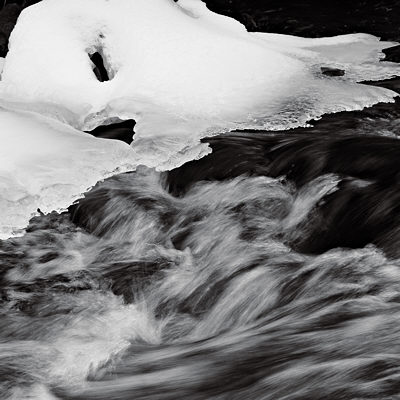 1
1
more… »
Posted by Steve Durbin on April 17th, 2008
While reworking and sequencing my Winter Water project, I realized that, for a photographer as well as a physicist, snow, ice, and liquid are very distinct states of water, with distinct texture, tone, and shape. Perhaps because those photographs had no sky, I managed to completely forget about the vaporous state. Last Monday, however, I was vividly reminded of that glorious phase while biking through Yellowstone. Roads were clear but cars not yet allowed, so I had it almost to myself: only a half dozen other bikers all day, and a few service vehicles per hour. Fortunately I had a late start, so by the time I reached the Lower Falls it was well on in the afternoon. The westerly light left the falling water in shade while illuminating the mist.
more… »
Posted by Steve Durbin on March 11th, 2008
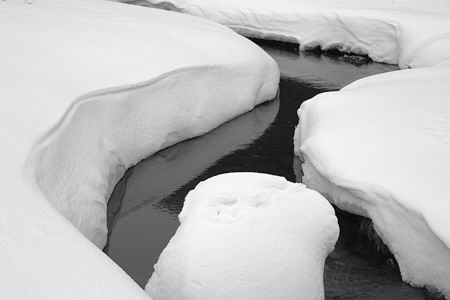
Natural black and white minimalism as well. To a certain extent, photographers choose (or are chosen by) their style when they choose their subject. Of course, the way of framing the subject plays an essential role. But in landscape photographs larger than minute details, it’s hard to find an uncluttered field of view. Winter simplifies.
Since I seem to have a natural inclination toward abstraction, you can well imagine I was delighted to find these snow forms in the wandering branches where the young Gallatin River is still figuring out where it belongs. I was also delighted to be on a pair of broad back country skis, a rental substitute for my 15-year old kit that had finally broken multiple places in every component, to the point it really was not usable even by an anti-gear guy like myself. The new skis allowed me to move easily along and among these streams, despite the deep, soft snow. I would gladly have spent all day there, had I been free.
more… »
Posted by Steve Durbin on March 4th, 2008
Seems like everybody is making a book these days. Lower prices and improvements in quality have made publish-on-demand an intriguing proposition. Reviews are mixed, but I’ve reached the point where I’m interested in giving it a try. Since I tend to work in projects, there are several bodies of work that are candidates for books. I’ve decided to look first at the smallish number of images in the set I’ve called Winter Water, some of which have been placed on my not up to date web site, or discussed here and there on A&P.
A book is necessarily presented as a linear sequence of pages, though a reader (is it still a reader if there are only photographs?) may not follow that order. Nevertheless, assuming one image per page for maximum resolution, it’s an interesting question to consider what sequence might work best. It’s akin to hanging pictures in an exhibit. As I am neither illustrating a narrative nor providing a guide to Pine Creek Falls in Paradise Valley in late November, I am not bound by the order in which the photographs were made or the physical layout of the falls. Considerations include interesting pictorial relationships, pacing, and the overall impression desired. None of these is at all well-defined, and I come up with a different order every time I sit down to it. I make no claims for the latest version shown below; in fact, I’m asking for your help.
more… »
 1
1 2
2
 1
1 1
1